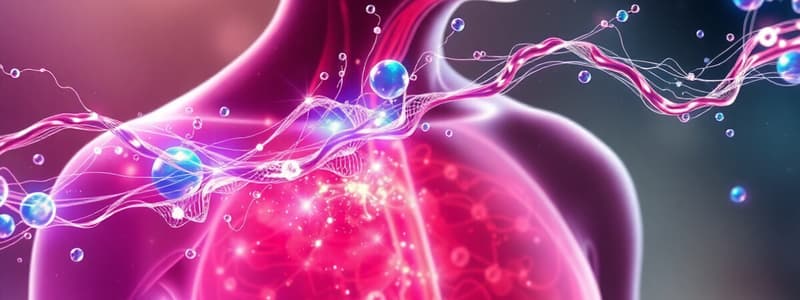Podcast
Questions and Answers
Flashcards
Atomic Concept
Atomic Concept
The smallest unit of a concept that can stand on its own.
Testing Effect
Testing Effect
Improved memory by actively retrieving information.
Flashcard Component
Flashcard Component
A single piece of information in a flashcard.
Progressive Learning
Progressive Learning
Signup and view all the flashcards
Flashcard Design
Flashcard Design
Signup and view all the flashcards
Study Notes
Osmoregulation
- Osmotic pressure is the pressure needed to offset the movement of pure solvents (e.g., water) across a semipermeable membrane.
- Hydrostatic pressure is the pressure exerted by a fluid on its surroundings.
- Blood pressure on vessel walls contributes to hydrostatic pressure.
- Pressure in fluid increases with depth.
Ionic Concentration and -tonic Solutions
- Ionic concentration refers to the concentration of ions in a solution.
- Semipermeable membranes allow certain substances to pass through.
- Initially, there is a net movement of water from one side to the other.
- At equilibrium, there is no net movement of water.
Electrolyte Composition of Body Fluids
- Serum and ECF (extracellular fluid) have similar electrolyte compositions.
- Key electrolytes like Na+, K+, Ca2+, and Cl- are listed along with their respective concentrations in different body fluids.
- Active transport and diffusion are methods used during metabolism in maintaining the electrolyte balance in the body.
Homeostasis Challenges
- Animals maintain homeostasis depending on their environment.
- Blood concentration relative to the environment influences urine concentration and osmoregulatory mechanisms.
- Different animals have varied strategies like drinking seawater or excreting excess salt.
- Examples include marine elasmobranchs, marine teleosts, freshwater teleosts, amphibians, and marine reptiles.
Water Gain and Loss
- Mammals, including kangaroo rats, maintain balance between water gain and loss in their environment.
- Water gain pathways and losses include intake of water, drinking, and metabolic water production.
- Water loss pathways include urine, feces, evaporation/perspiration, and respiration.
Respiratory Evaporative Water Loss
- Respiratory water loss is affected by relative humidity, air temperature, and breathing rate.
- Inhaled air warms and humidifies as it passes through the nasal passages and lungs.
- Exhaled air cools and loses moisture, which is a form of evaporative loss.
- There is a correlation between water loss through respiration and ambient air temperature.
Mammalian Kidney Adaptation
- Kidney structure relates to environment.
- Beaver's have short loops of Henle, while desert dwelling animals like kangaroo rats have long loops of Henle.
- These adaptations reflect their respective environment's water availability.
Metabolic Water
- By definition, metabolic water is water produced as a result of metabolic processes, rather than from food intake or external sources.
- Oxidation of foodstuffs in the body produces metabolic water.
- Carbohydrates produce the most metabolic water (0.56 g of water per gram).
- Lipids are more water-efficient than Carbohydrates and proteins in producing metabolic water.
Fat and Protein Stores as Water Sources
- Migratory birds rely on stored fat for energy and water.
- Fat stores can release more water than glycogen stores.
- Protein degradation can release bound water.
- The need for energy and water is balanced with storage mechanisms in organs.
Hummingbirds and Dehydration
- Contrary to some assumptions, hummingbirds' dehydration regulation is not a daily problem.
- Frequent water intake and maximum glucose reabsorption offset urine dilution.
- Concentrated glucose absorption has significant roles in water retention.
Carb Absorption
- Carbohydrate absorption in the intestine involves several stages.
- Maltose is broken down to glucose.
- Glucose is absorbed via active transport with Na+ entering the cell.
- Glucose then leaves enter the blood by facilitated transport.
Glucose Re-absorption
- Active transport, facilitated diffusion, and sodium-potassium pumps assist in glucose reabsorption within the kidneys.
Type II Diabetes
- Hyperglycemia (high sugar) is a common symptom.
- Sweet-tasting urine was an historical diagnostic indicator.
Blood pH Regulation
- Blood pH is regulated by maintaining appropriate levels of bicarbonate and hydrogen ions.
- The kidneys and carbonic anhydrase play a role in maintaining an appropriate balance between these.
- The kidneys help maintain an internal equilibrium of these levels.
Urine Acidification
- Ammonia and phosphates act as buffers for urine.
- Urine pH is generally lower than blood pH.
- The protein in our diet affects the acidity of urine.
Vasopressin
- Also known as antidiuretic hormone (ADH), vasopressin regulates water reabsorption in the kidneys.
- Released in response to high plasma osmolarity or low blood pressure.
- Stimulates aquaporins which are proteins, to increase water permeability in collecting ducts, allowing more water to be absorbed.
- High blood osmolality or low blood pressure stimulates vasopressin production and release.
Hypertension
- Body regulates blood osmotic pressure by adjusting sodium levels in the kidneys.
- Excess sodium intake can lead water to be retained in the blood, which increases blood pressure.
- Medications such as ACE inhibitors and Angiotensin Receptor blockers can be used to manage high blood pressure.
Renin-Angiotensin-Aldosterone (RAA) Pathway
- Juxtaglomerular cells release renin in response to low blood pressure or low glomerular filtration rate (GFR).
- Renin converts angiotensinogen to angiotensin I, and then to angiotensin II , which has various effects on the cardiovascular system, including vasoconstriction and secretion of aldosterone.
- Aldosterone promotes sodium and water retention, while raising blood pressure.
Studying That Suits You
Use AI to generate personalized quizzes and flashcards to suit your learning preferences.




